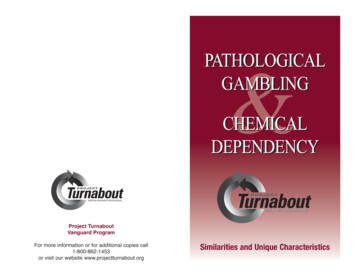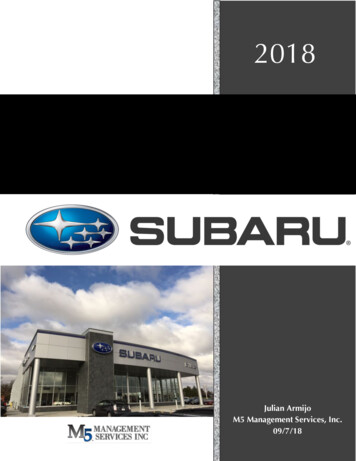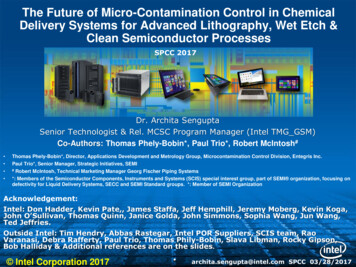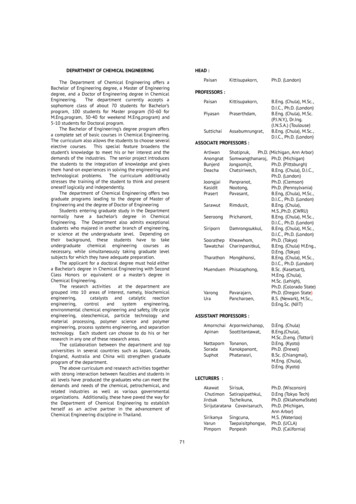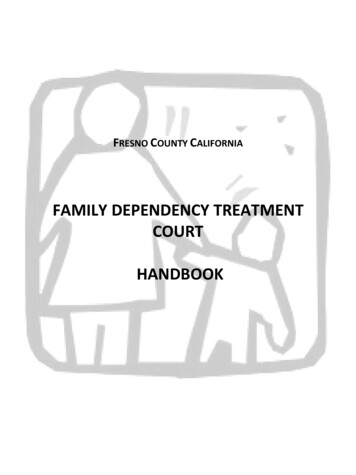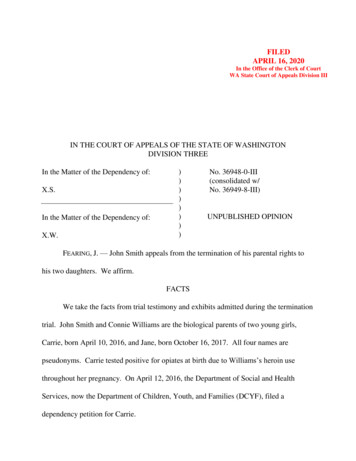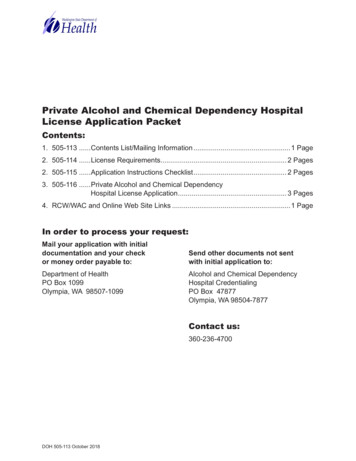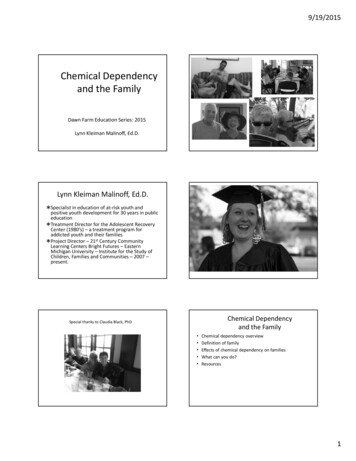
Transcription
9/19/2015Chemical Dependencyand the FamilyDawn Farm Education Series: 2015Lynn Kleiman Malinoff, Ed.D.Lynn Kleiman Malinoff, Ed.D. Specialist in education of at-risk youth andpositive youth development for 30 years in publiceducation Treatment Director for the Adolescent RecoveryCenter (1980’s) – a treatment program foraddicted youth and their families Project Director – 21st Century CommunityLearning Centers Bright Futures – EasternMichigan University – Institute for the Study ofChildren, Families and Communities – 2007 –present.Chemical Dependencyand the FamilySpecial thanks to Claudia Black, PhD Chemical dependency overviewDefinition of familyEffects of chemical dependency on familiesWhat can you do?Resources1
9/19/2015What is CD addiction? Addiction is characterized by inability to consistentlyabstain, impairment in behavioral control, and craving,diminished recognition of significant problems withone's behaviors and interpersonal relationships, and adysfunctional emotional response. Like other chronicdiseases, addiction often involves cycles of relapse andremission. Without treatment or engagement inrecovery activities, addiction is progressive and canresult in disability or premature death.Addiction is a disease. It has defined signs andsymptoms It is chronic It is progressive It is fatal, if not treatedWhat is CD addiction, accordingto NIDA? Addiction is a primary, chronic disease of brain reward,motivation, memory and related circuitry. Dysfunctionin these circuits leads to characteristic biological,psychological, social and spiritual manifestations. Thisis reflected in an individual pathologically pursuingreward and/or relief by substance use and otherbehaviors.Biological/Physical Effects Chemical tolerance Withdrawal symptoms Chemically dependent people crave drugsand physically do not feel normal withoutthem2
9/19/2015Signs and Symptoms Frequent intoxicationOnce user starts, can’t stopBlackoutsBehavior changes while usingBegins to miss work or otherobligations, like familySigns and SymptomsLegal troublesDrug taking in larger amounts than intendedInability to cut down on drug useA great deal of time spent in activities necessary toobtain the drug and Continued use despite negative consequences Psychological Effects Drugs control mind, thinking, attitude,beliefs Drugs control their moods Believe life is not possible without drugs Obsessive thoughts about drug Love relationship with drugAddiction is Chronic Symptoms arise and last over time Interrupts the developmental cycle Time not spent developing talents, skills,interests Time spent in detention, jail, prison May begin with an acute event (or more thanone) Eventually just becomes ‘routine’Addiction is Progressive Stages– Early May be asymptomatic– Middle Tends to be when use affects relationships, life, work,etc.– Late Obvious symptomsAddiction is Fatal If left untreated, addiction to drugs willeventually kill by disease, overdose, or accidentor lead to incarceration or institutionalization. Drug related car and other accidents, Violent activities, dangerous behaviors, gangs,fights, burglaries, homicide Overdose Suicide, attempted suicide Diseases related to drug use3
9/19/2015family [ˈfæmɪlɪ ˈfæmlɪ]n pl -lies1. (Sociology)a. a primary social groupconsisting of parents and their offspring, the principal function of which isprovision for its membersWhat is missing here?A family is This disease is a FAMILY DISEASE! Whether thealcoholic is a parent or child, the other familymembers are often taken hostage!Common features of familiesThe years of living with an alcoholic isalmost sure to make any wife or childneurotic. The entire family is to someextent ill. Unique rolesShared rolesRules—spoken or unspokenValues and beliefsShared history Alcoholics Anonymous – p.1224
9/19/2015And everythingreflects the changeFamilies are Systems Until something changes Role shiftsChanged responsibilitiesRules are brokenUpended values and beliefsLoss of historyDenial sets inChemical Dependency Changes: How it feels to live in the family How people communicate How family members relate to each other andget along How family members dealwith problems and conflictsChemical Dependency Changes: How family members meet each other’s needs How members assume roles and meet thedemands of these roles How family members relate to the outside world:We often recreate our family relationships inother relationships!5
9/19/2015The alcoholic is like a tornado roaring his waythrough the lives of others. Hearts arebroken. Sweet relationships are dead.Affections have been uprooted. Selfish andinconsiderate habits have kept the home inturmoil.Alcoholics Anonymous – p.82Characteristics of the Alcoholic orChemically Dependent Family The Centricity of the Alcoholic Denial and Shame Inconsistency, Insecurity and Fear Anger and Hatred Guilt and Blame Resentments developIt brings misunderstanding, fierceresentments, financial insecurity,disgusted friends and employers,warped lives of blameless children, sadwives and parents. Anyone canincrease the list.Alcoholics Anonymous – p. 18Denial and ShameResulting Disappointmento The chemically dependent person is unableto live up to his or her commitments andpromises.o Broken promises and unfulfilledexpectations are common.o Members of the family are constantlyhaving their high hopes turn into greatdisappointments.6
9/19/2015Anger and HatredGuilt and BlameEmbarrassmentResentment is like taking poison and waiting forthe other person to die.7
9/19/20153. Don’t Feel.1. Don’t talk.2. Don’t trust.Ways Family MembersReduce Stress Ignoring the problem behaviors, conflict, and pain Using defense mechanisms (both the chemicallydependent person and other family members –denial, minimization, approval seeking, victimization ) Taking on new roles to stabilize the family – childrencaring for children, protecting the family secret8
9/19/2015Family RolesThe ScapegoatThe HeroThe ScapegoatThe Lost ChildThe MascotThe Chief EnablerThe HeroThe Scapegoat Behaviors: Tests limits, breaks rules, gets in trouble, acts aggressively, usessubstances as an outlet/relief, inappropriate language, behavior, dress,usually has most realistic picture of the family. Feelings: Anger, confusion, resentment, inadequacy, self-blame for familyproblems, “out of control” As an adult: Typically has progressive substance abuse problems; problemsthroughout life; progressive involvement with the criminal justice systemOffers the family a sense of purpose byproviding someone to blameThe HeroThe Lost Child Behaviors:– High achiever, excels, leads, very busy, almost never says no,responds to adult, controlling Feelings:– Anxiety, inadequacy, unworthiness, resentfulness, self-blame,loneliness As an adult:– Unrealistic sense of control, needs to control, needs approval,feels overly responsible or may act irresponsibly whenoverwhelmedOffers the family a sense of being okay9
9/19/2015The Lost ChildThe Chief Enabler Behaviors: Quiet, daydreamer, isolates, fantasizes, avoids conflict, passive Feelings: Loneliness, fear, unworthiness, inadequacy, lack of fulfillment As an adult: May have problems with depression, difficulty with interpersonalrelationships, alcohol or drug problems usually due to inability tocopeOffers the family a sense of relief and success, and isnot a trouble to the familyThe MascotThe Chief Enabler Behaviors:– Shelters and shields the using family members, makes excuses forand may lie to protect the user, minimizes negative consequences,blames others for the problems, sometimes sabotages progresstowards recovery Feelings:– Anger, hurt, guilt, resentment, anxiety, fear, desperate to controleverything, helpless, exhaustedOffers the family a senseof stability and protectionThe Mascot Behaviors:– Class clown, seeks attention through humor and actingout, uses humor to keep people at a distance, seldomserious Feelings:– Anxiety – measures self-worth by how others see him orher; anger; hurt; loneliness As an adult:– Problems in school and at work, seldom forms intimaterelationships, “clowns around” or “life of the party,” maydevelop SA problemsOne in four children live in ahome where alcoholism oralcohol abuse is present daily.Can be a parent/guardian or asibling!Offers the family a senseof comic relief from the pain10
9/19/2015Children in CD homes are: 3 times more likely to be verbally,physically, or sexually abused 4 times more likely to beneglected 4 times more likely to developchemical dependency problems oftheir ownChildren in CD homes are at greatrisk for: Emotional problems Physical health problems Learning difficultiesWhat if .my child has a problem with drugs oralcohol?11
9/19/2015From parents who know: Horrible to havealcoholic husband waymore difficult andconfusing to have analcoholic child. ALanon helped in theprocess of helping gethim in treatmentwithout blame orshame. Interventionist reallyhelped. Give them the dignity toexperience theconsequences and asparents, recognize theconsequences as goodnews.What’s a family to do?Develop an understanding and acceptance thataddiction is a disease.More wisdom from experience Kicking her out saved herlife! Someone told me togo to Alanon took me 6months from the time ofkicking her out to go backto alanon. Then I gothealthy. In the middle of all of it,the important thing forme was recognizing thatwhen things unfold, theconsequences of their useand action thoseconsequences are goodnews. . I don’t need to make theconnections for them,those consequences aremotivators. From a recovering youngson, “God and mom arealike, they both neverturned their back on me.“Is there hope?12
9/19/2015 A systemic disease needs systemictreatment Chemically dependent families havechoices and can break the unhealthy normsof the family. It doesn’t matter why these roles weredeveloped, they do not have to bemaintained!Enabling “Standing between a person and his orher consequences.” “Doing for someone something he or sheshould be doing for him or herself.” “Engaging in actions that ultimatelyperpetuate someone’s problematicbehavior.”Recovery Al-AnonThe alcoholic may find it hard to establish friendly relationshipswith his children .They cannot seem to forgive and forget In time they will see he is a new man and in their own way theywill let him know it. From this point on, progress will be rapid.We who live or have lived with the problem of alcoholismunderstand as perhaps few others can. We, too, were lonelyand frustrated, but in Al-Anon we discover that no situation isreally hopeless, and that it is possible to findAlcoholics Anonymous – p. 134 (The FamilyAfterward)contentment, even happiness, whether thealcoholic is still drinking or not.How Al-Anon Works – p. 8Parent of an addicted child?Spouse of an addict? Seek professional help Attend AlAnon or Families Anonymous Learn about co-dependency andenabling. Learn to NOT ENABLE.13
9/19/2015The family situation is bound toimprove as we apply the Al-Anonideas. Without such spiritual help,living with an alcoholic is too muchfor most of us. Our thinking becomesdistorted by trying to force solutions,and we become irritable andunreasonable without knowing it.How Alanon Works – p. 8It’s work!The battle against alcoholism has become thebasis for many of our relationships. Putting anend to this battle requires completelyredefining what we believe about ourselves,others and our relationships.How Alanon Works – p. 46Resources/references It Will Never Happen to Me – ClaudiaBlack Codependent No More – MelodyBeattie Broken Bottles, Broken Dreams –Charles Deutsch www.dawnfarm.org http://www.adultchildren.org http://www.al-anon.alateen.org http://www.afgdistrict5.orgData were obtained from the following sources:Love the person, hate the diseaseU.S. Department of Health and Human Services. SAMHSA's Center forSubstance Abuse Treatment. You Can Help: A Guide for Caring AdultsWorking with Young People Experiencing chemical dependency in theFamily (PHD878, (SMA) 01-3544)Washington, DC: U.S. GovernmentPrinting Office.University of Pennsylvania Health System: http://www.uphs.upenn.edu/14
Chemical Dependency and the Family Dawn Farm Education Series: 2015 Lynn KleimanMalinoff, Ed.D. Lynn Kleiman Malinoff, Ed.D. Specialist in education of at-risk youth and positive youth development for 30 years in public education Treatment Director for the Adolescent Recovery Center (1980's) -a treatment program for addicted youth and their .


